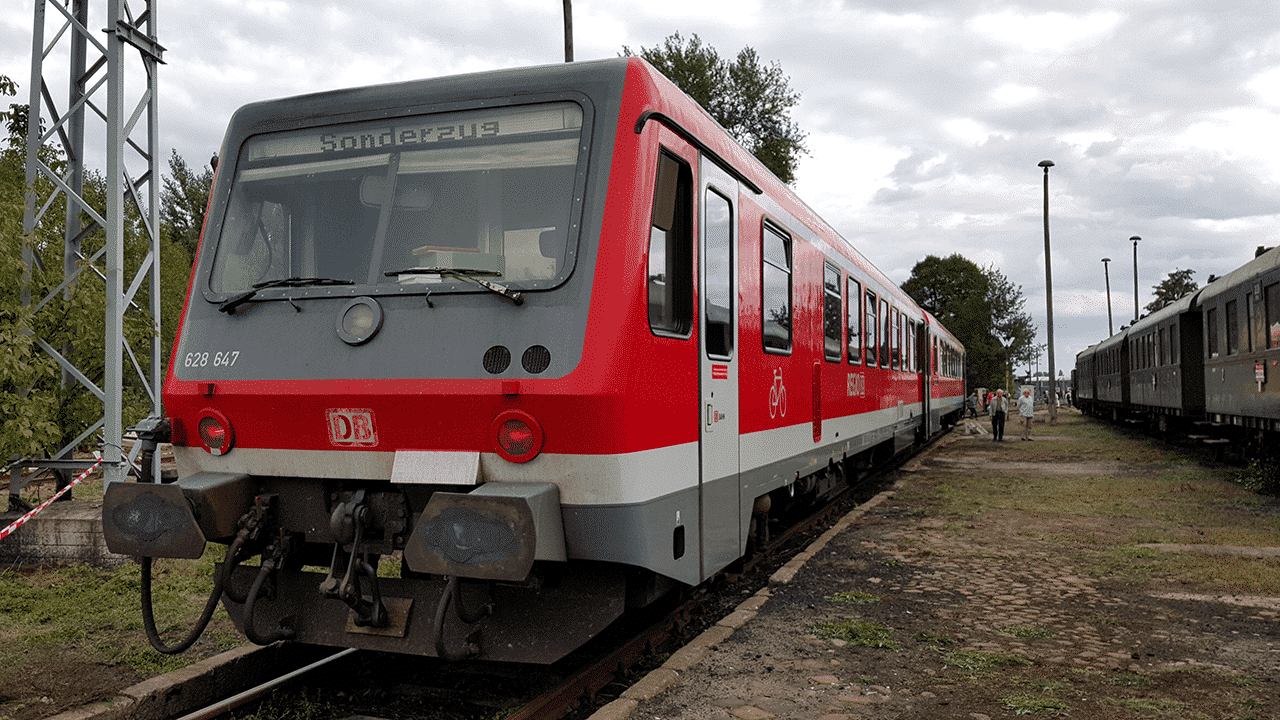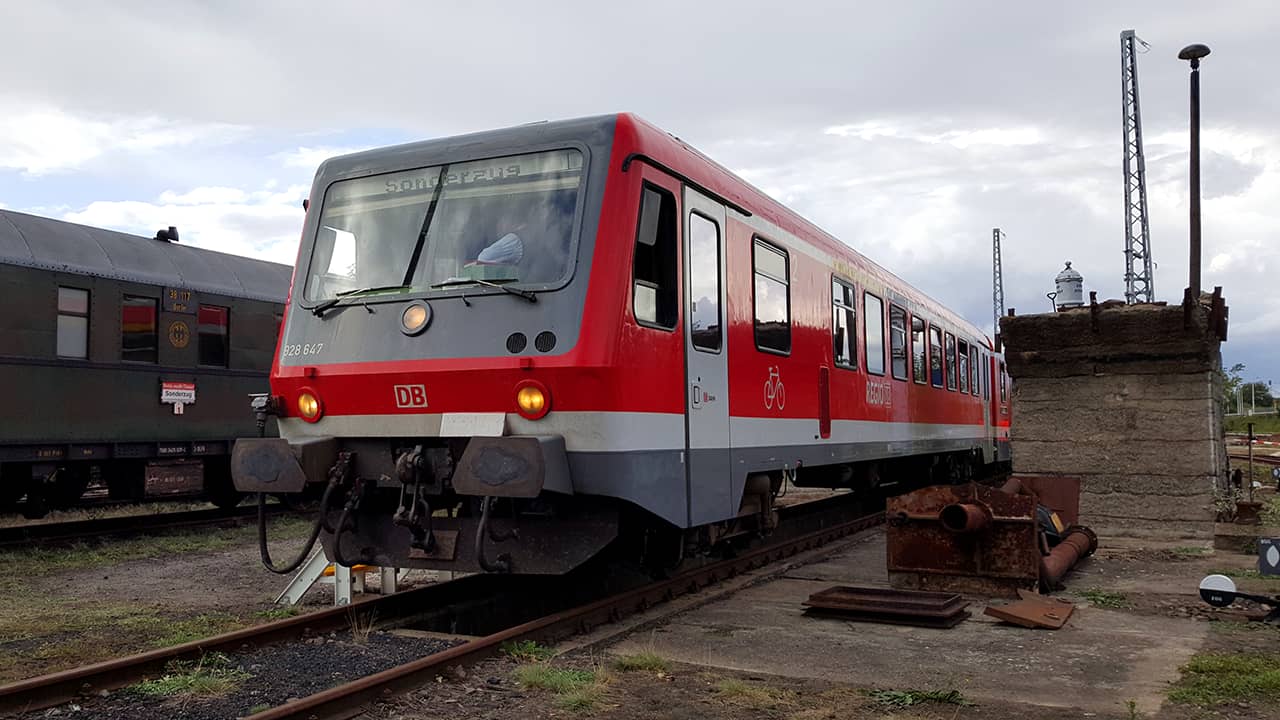DB Class 628 - two-part diesel railcars of Deutsche Bahn
The DB Class 628 railcar, also known as VT 628, is a two-car diesel railcar of DB AG. The railcar consists of a motor car (628) and a control car (928) or two motor cars (class 629), which is only the case with a few exceptions. In the German Vehicle Adjustment Register, the series number 95 80 0628 was assigned to these railcars.
The DB Class 628 was used throughout Germany in food traffic on secondary and subordinate main lines. Thus, the railcar is considered the successor of the rail buses.
| Manufacturer: | Düwag, Waggon-Union, AEG, LHB, MBB |
| Length: | 44.35 m / 45.15 m / 45.40 m / 46.40 m / 46.40 m |
| Numbering: | 628 001-024 (+928.0 or 628.0) 628 101-103 (+928. 1) 628 201-350 (+928.2 or 629.2) 628 401-704 (+928.4) 628 901-905 (+629.0) |
| Weight: | 64.0 t / 63.6 t / 66.6 t / 69.9 t / 84.0 t |
| Years of construction: | 1974-1975 (628.0) 981 (628.1) 1986-89 (628.2) 1992-96 (628.4) 1994-95 (628.9/629.0) |
| Top speed: | 120 km/h (140 km/h, 629 series only) |
| Retirement: | 628.0: Until 2005 628.1: Until 2008 628.2/.4: Partial retirement due to lack of demand |
| Number: | 12 (628.0) 3 (628.1) 150 (628.2) 309 (628.4) 5 (628.9/629) |
| Power: | 2× 213-221 kW / 357 kW / 410 kW / 485 kW / 2× 485 kW |
| Engine type: | MAN D 3256 BTXUE or KHD F12 L 413 / DB OM 424 A / DB OM 444 A / MTU 12 V 183 TD 12 / ditto |
| Power transmission: | hydrodynamic |
| Fuel supply: | 2x 675 l / 800 l + 250 l / 960 l + 240 l / 960 l + 250 l / 2x 960 l + 2x 250 l |
| Train protection: | Sifa, PZB 90 |
| Axle formula: | B'2'+2'B' (628.0) 2'B'+B'2' (628.9/629(.0)) 2'B'+B'2' (628.3/629.3) 2'B'+2'2' (rest) |
| Seats: | 136 + 0 + 0 / 128 + 0 + 21 / 112 + 10 + 21 / 112 + 12 + 22 / 116 + 12 + 16 (2nd class + 1st class + emergency seats) |
| Interesting facts |
|---|
| The DB Class 628 railcars have different axle formulas and they are as follows. B'2'+2'B' (628.0) Two driving axles independent of the main frame, coupled together and running in one bogie, as well as two running axles united in one movable bogie and two running axles united in one movable bogie, as well as two driving axles independent of the main frame, coupled together and running in one bogie. 2'B'+B'2' (628.9/629(.0)) Two running axles joined in a mobile bogie and two driving axles independent of the main frame and coupled together and running in a bogie, as well as two driving axles independent of the main frame and coupled together and running in a bogie and two running axles joined in a mobile bogie. 2'B'+B'2' (628.3/629.3) Two running axles joined in a mobile bogie and two driving axles independent of the main frame and coupled together and running in a bogie, and two driving axles independent of the main frame and coupled together and running in a bogie and two running axles joined in a mobile bogie. 2'B'+2'2' (rest) Two running axles united in a movable bogie and two driving axles independent of the main frame and coupled together, running in a bogie, as well as two running axles united in a movable bogie and two further running axles united in a movable bogie. More interesting facts |
The history of the DB Class 628 railcars
The DB Class 628 railcar was developed in the 1970s as the successor to the 795 and 798 railbuses. The concept for the railcar was developed in cooperation with the Bundesbahn-Zentralamt Munich and Waggonfabrik Uerdingen and was intended to replace the 515 series railbuses and accumulator railcars. The aim was that these vehicles could also be used on the main lines. This meant that it was necessary to increase the speed, the brake system and the comfort compared to the rail buses.
Furthermore, they should not be more expensive in terms of operating costs than a rail bus. In 1974 the Waggonfabrik Uerdingen and MaK could present a two-part prototype 628 (.0) and a one-piece variant, the class 627, on routes with little passenger traffic. The lack of efficiency of the machinery was nightly with these vehicles. After test runs in the Netherlands and Denmark, the MR railcars for the Danish state railway and the DH1 and DH2 railcars for the Dutch state railway were designed and produced in series on the basis of the vehicles 628(.0) and 627.
The trainsets 628 004/014, 628 005/015, 628 009/019 and 628 010/020 were first stationed at the Braunschweig station and from there reached the non-electrified lines in Harz and Weserbergland. The remaining 628.0 were stationed at the Kempten station. The Braunschweig 628.0 followed in June 1980. The 628.0 were used on all lines in the Allgäu region until the end of 2002 and experienced a reduction in the radius of operation to the external long-distance railway in 2003. In January 2005 the last vehicle of this series was finally parked. Some vehicles were already scrapped and others sold to Poland, where they were used for the Koleje Mazowieckie.
In 1981 the 628.1 multiple unit was presented, of which there were only 3 units. The most important difference to the DB Class 628.0 was the omission of the second machine, because the remaining engine was strong enough. The second part of the car could become the control car 928.1. These vehicles also achieved a higher economy, since one of the two toilets and one of previously four entrances per side was omitted and equipment for the one-man operation was used.
In addition to the two-piece version 628.1 there was also the one-piece version 627.1, of which there were only 5 prototypes. The 628.1 vehicles proved themselves excellently in the tests, so that series production followed. The one-piece variant did not go into series production. The VT 628 102 was the only vehicle to have a 1st class. The 628.1 was also stationed in the Allgäu region and used until December 8, 2007 with its own schedule on the external long-distance railway, including the Illertalbahn. At the beginning of 2008, the 628.1 were put on z-route and transferred to Hamm. In 2011, the 628 102 and 103 multiple units were sold to Canada.
Before series production of the 628.2 series began, a number of short-term wishes were integrated, including a small 1st class large-capacity compartment, improved ventilation and a partition between the driver’s cab and passenger compartment. Important exterior and technical changes were the more tilted front wall, the top light, which was installed under the windscreen, a total of four electronic target displays on the front and side walls and an increase in the number of non-smoking places. The first vehicles of the 628.2 were delivered in the new product colours minttürkis/pastelltürkis/lichtgrau. A multiple unit cost DM 2.27 million at that time.
Between 1986 and 1989, 150 units of this multiple unit were purchased. By mid-2017, 27 628.2 series multiple units were still in service, two of which were still coupled to a second 629.3 motor car. The 628.2 will be used as planned in Hesse, Rhineland-Palatinate, Baden-Württemberg and Bavaria. The first 628 201/928 201 motor coach was brought to the DB Museum in Koblenz in March 2015, where it was returned to its original delivery condition.
The second 628.4 series incorporated the experience gained in everyday operation. In 1992, Düwag introduced the 628.4 railcar. The technical improvements were the charge air cooling, which increased the performance of the diesel engine by 20% and the omission of the lower pane with the doors, as well as the installation of double doors at the short coupling end. The vehicles were also extended by 50 centimeters. Between 1992 and 1996, a total of 309 railcars were built, some of which went to other railway companies, including Luxembourg and Romania
Summary of the DB Class 628 railcar
The Series 628 railcars are distinguished by their reliability and economy. Although the trains were not completely free of technical problems over the years, the list of shortcomings is very short. The cooling water, for example, tends to overheat on hot days if the radiators have not been thoroughly cleaned.
The necessary speeds were reached only hesitantly or not at all due to the low friction weight. There were also comfort features that the DB Class 628 railcar did not meet, including the non-air-conditioned passenger compartment, the non-barrier-free boarding area and the lack of modern passenger information systems. The engine performance of the DB Class 628 is comparatively weak, so that the journey time has been significantly extended on steeper routes. For this reason, the multiple units were nicknamed “Wanderdüne”.
For lines where a stronger drive is required, the 628.9/629 trains, consisting of two motor cars, are used. For newer vehicles such as the 641 series, the Desiro (DB Class 642), the Talent (643 and 644), the LINT (648), and the Regio-Shuttle (650), which replace the 628, two machine systems are used again.


